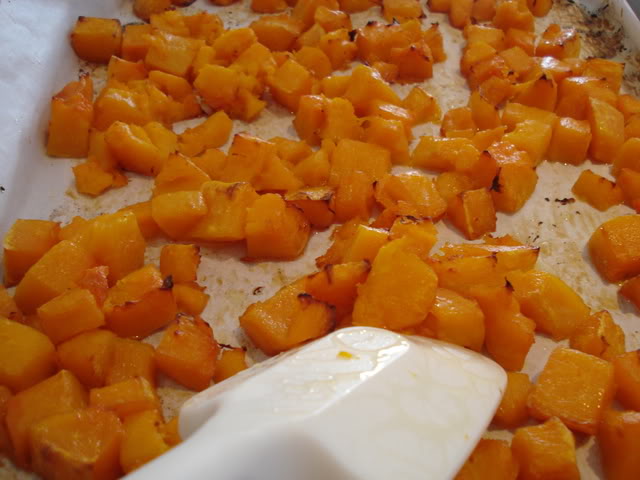Quote:
Those are some gorgeous looking Squash!
Originally posted by
Alys
First things first: preheat the oven to 400 degrees F (approx. 205 C).
While oven is preheating peel and chop squash into about 1 inch pieces. Line a baking tray with parchment paper (not entirely necessary, I just hate to clean pans) ... more
While oven is preheating peel and chop squash into about 1 inch pieces. Line a baking tray with parchment paper (not entirely necessary, I just hate to clean pans) ... more
First things first: preheat the oven to 400 degrees F (approx. 205 C).
While oven is preheating peel and chop squash into about 1 inch pieces. Line a baking tray with parchment paper (not entirely necessary, I just hate to clean pans) and mix the squash pieces with the veggie oil and salt. If you’re using regular table salt, decrease the amount to about 1/2 tsp.
A butternut squash is easier to break down if you cut the neck away from the round bottom part. You’ll find it a lot easier to get your knife through half of the squash at a time.
(I actually did a double batch here, which is why you’ll see two baking trays of squash. I served some for dinner and froze the rest for later.)
Funfact #1: There is still dispute amongst historians as to whether or not squash originated from the American continent, though most agree that it was not introduced to Europe before Columbus “found” the Americas. less
While oven is preheating peel and chop squash into about 1 inch pieces. Line a baking tray with parchment paper (not entirely necessary, I just hate to clean pans) and mix the squash pieces with the veggie oil and salt. If you’re using regular table salt, decrease the amount to about 1/2 tsp.
A butternut squash is easier to break down if you cut the neck away from the round bottom part. You’ll find it a lot easier to get your knife through half of the squash at a time.
(I actually did a double batch here, which is why you’ll see two baking trays of squash. I served some for dinner and froze the rest for later.)
Funfact #1: There is still dispute amongst historians as to whether or not squash originated from the American continent, though most agree that it was not introduced to Europe before Columbus “found” the Americas. less







